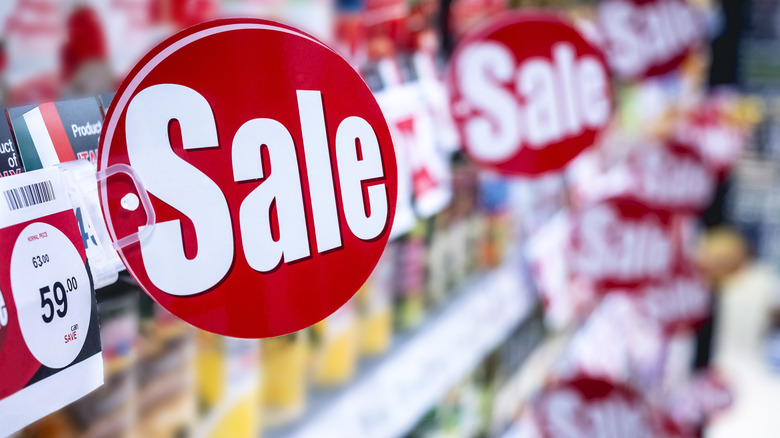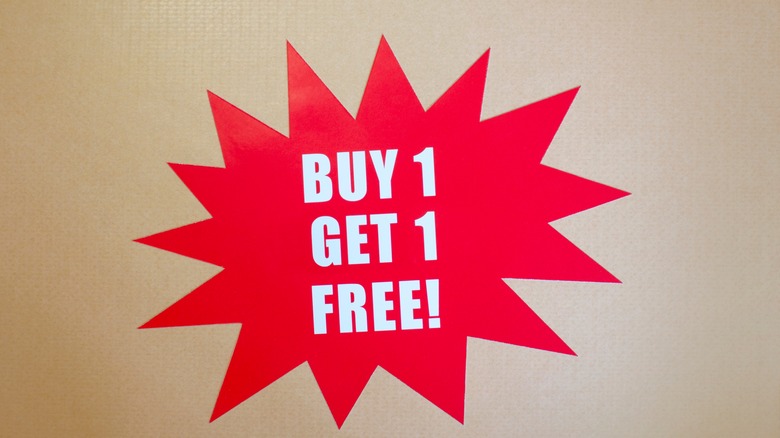The Grocery Discount Gimmick You Should Always Read The Fine Print On
Whether you're shopping for clothes or getting groceries, chances are you've seen promotions such as "buy one, get one free" or "free gift with every purchase." These promotions typically promise steep discounts, an alluring gift or bonus item, or offer what seems to be an "exclusive deal." While no one is exactly sure who invented these types of wild, sensational promotions — some sources like The Hustle believe that the first "buy one, get one free" deal originated sometime in the early 1900s while others think that the deal goes back as far as the 1700s — it's clear that these promotions are a great way to bring in customers no matter what you're selling.
Another notable example of such a promotion is "one item for $1." You may be in the grocery store when you see an advertisement for something like apples or candy bars, claiming that you could purchase five apples for $5 or 10 candy bars for $10. On the surface, it doesn't sound too bad a deal — after all, for the relatively low price of $10, you can have so many apples or candy bars you wouldn't know what to do with them. This clever wording is there to make you fill up your cart, but before you do it's worth asking this question: Do you actually need the quantity they're trying to get you to buy?
You don't have to buy that many to take advantage of the deal
$10 for 10 apples or 10 candy bars does sound like a fair trade, sure. But when you really think about it, what would you do with 10 apples or 10 candy bars anyway? That would just be spending money for something you really don't need — just because it sounds like you're getting a great deal. Fortunately, you don't have to buy the maximum amount to take advantage of this offer.
According to Ashley Boyd — a former Kroger manager who spoke to The Kitchn – you don't have to buy the maximum number of the product in a deal like this. It's mainly just a gimmick that grocery stores use to show off their "big savings" and get customers to feel like they're getting a really good deal. People love getting more for less after all. But Boyd explains that you could probably buy each product for about $1 apiece rather than spend the whole $5 or $10 price point. In our apples and candy bar example, you could get, say, 3 apples for $3 or 5 candy bars for $5. You don't have to spend money just for the sake of it. That big number is only meant to draw you in, and it's not a concrete specification or condition. Of course, Boyd recommends speaking to a clerk about the sale first, just so you know exactly what the deal entails or specifies.
These types of deals are usually centered around low-cost items
Wouldn't it be great if everything was sold like how supermarkets sell their products? Imagine getting a new laptop and getting a second one free. Or buying a ticket to a concert and getting the other ticket half-off? We don't live in such a world unfortunately and these types of deals are usually reserved for items that are low-cost and already pretty inexpensive. But why is that?
There are a number of reasons for this. The manager of the store may be attempting to move products that would normally be harder to sell than most. While most people always buy things like bread and milk, most people don't often buy candy bars, nuts, and other small snack items as frequently as they do the essentials. By making these already inexpensive items more attractive, the manager would hope that more people purchase these products and move them from their shelves. It could also be that it's just another method to subliminally convince you to spend more money. When you're at the checkout line, and notice the rows of candy and gum are marked with a "one for $1" deal, it can be hard to resist the lure of a discounted treat.


